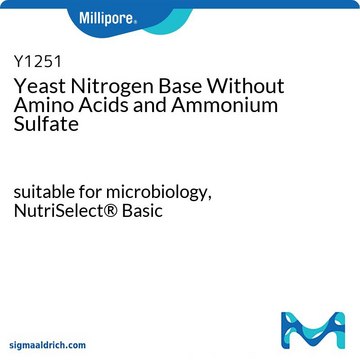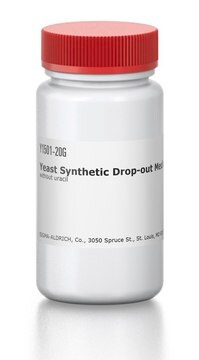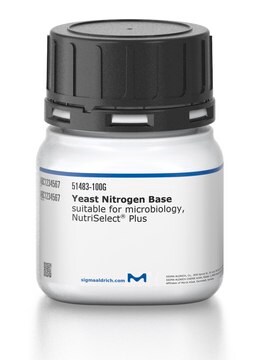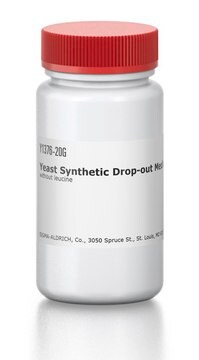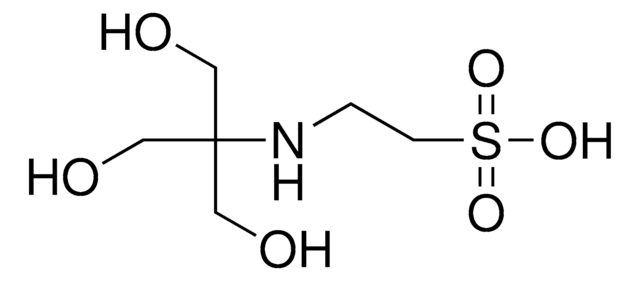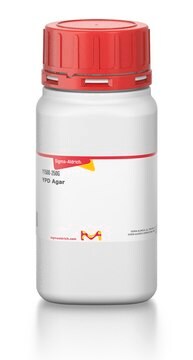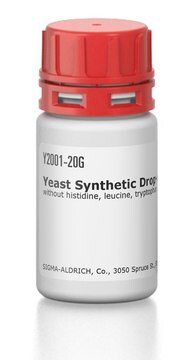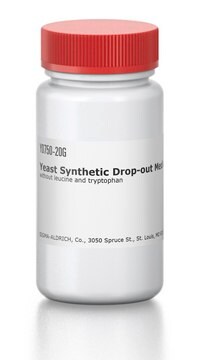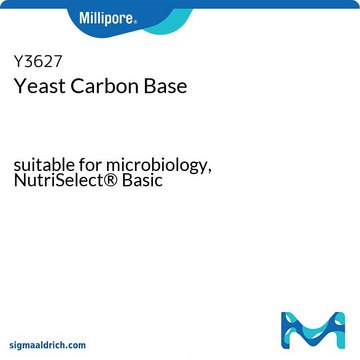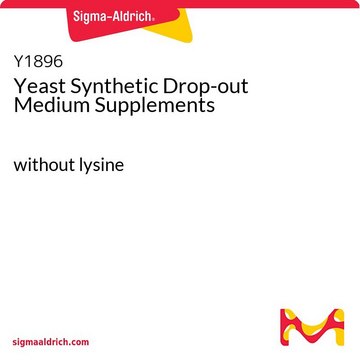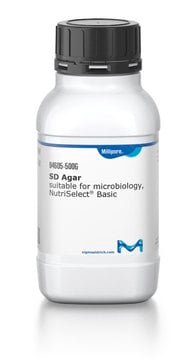Y0626
Yeast Nitrogen Base Without Amino Acids
Yeast classification medium used for selecting yeasts based on amino acid and carbohydrate requirements
Sinonimo/i:
ynb without amino acids
About This Item
Prodotti consigliati
Grado
for molecular biology
Livello qualitativo
Sterilità
non-sterile
Forma fisica
powder
tecniche
microbe id | utilization test: suitable
microbiological culture: suitable
pH
5.2-5.6(0.67% solution)
applicazioni
food and beverages
microbiology
Temperatura di conservazione
room temp
Compatibilità
nonselective for Candida spp.
nonselective for Pichia spp.
nonselective for Saccharomyces spp.
nonselective for Zygosaccharomyces spp.
yeasts
Descrizione generale
Applicazioni
- in synthetic complete supplement mixture (SC)-Leu media used for Y. lipolytica culturing and characterization
- as a component of selective liquid media for uracil auxothrophic growth in yeast
- to evaluate the transformation efficiencies of S. cerevisiae strains, under different nutrient conditions
Componenti
Nitrogen Sources:
Ammonium sulfate, 5.0 g/L
Vitamins:
Biotin, 2.0
Calcium pantothenate, 400
Folic acid, 2.0
Inositol, 2.0 mg/L
Nicotinic acid, 400
p-Aminobenzoic acid, 200
Pyridoxine HCl, 400
Riboflavin, 200
Thiamine HCL, 400
Trace Elements:
Boric acid, 500
Copper sulfate, 40
Potassium iodide, 100
Ferric chloride, 200
Manganese sulfate, 400
Sodium molybdate, 200
Zinc sulfate, 400
Salts:
Potassium phosphate monobasic, 1.0 g/L
Magnesium sulfate, 0.5 g/L
Sodium chloride, 0.1 g/L
Calcium chloride, 0.1 g/L
Nota sulla preparazione
2. Warm if necessary to solubilize and sterilize by filtration.
Store 10× stock solution at 2-8 °C. To use, dilute 1:10 with sterile distilled water under aspetic conditions.
Prodotti correlati
Codice della classe di stoccaggio
13 - Non Combustible Solids
Classe di pericolosità dell'acqua (WGK)
WGK 1
Punto d’infiammabilità (°F)
Not applicable
Punto d’infiammabilità (°C)
Not applicable
Dispositivi di protezione individuale
Eyeshields, Gloves, type N95 (US)
Certificati d'analisi (COA)
Cerca il Certificati d'analisi (COA) digitando il numero di lotto/batch corrispondente. I numeri di lotto o di batch sono stampati sull'etichetta dei prodotti dopo la parola ‘Lotto’ o ‘Batch’.
Possiedi già questo prodotto?
I documenti relativi ai prodotti acquistati recentemente sono disponibili nell’Archivio dei documenti.
I clienti hanno visto anche
Articoli
Technical Article on yeast media. Yeasts are eukaryotic microorganisms whose genomes have been comprehensively studied and some have been sequenced.
Traditional methods are based morphology, staining methods, enzyme reactions (metabolism) and diverse media.
Protocolli
Yeasts are considered model systems for eukaryotic studies as they exhibit fast growth and have dispersed cells. Yeast cultures can be grown, maintained, and stored in liquid media or on agar plates using techniques similar to those for bacterial cultures.
Il team dei nostri ricercatori vanta grande esperienza in tutte le aree della ricerca quali Life Science, scienza dei materiali, sintesi chimica, cromatografia, discipline analitiche, ecc..
Contatta l'Assistenza Tecnica.